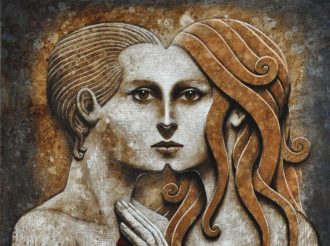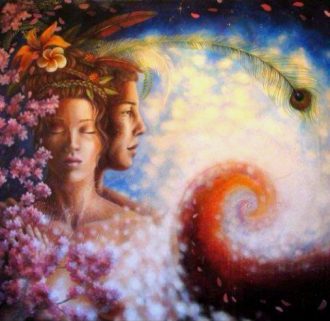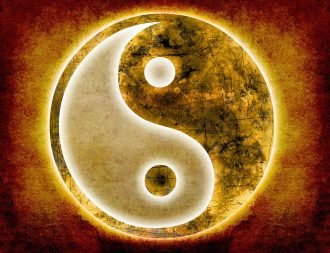November 29th, 2016
Guest writer for Wake Up World
Throughout almost all recorded history, and in most cultures throughout Europe, the Middle East and Asia, there has been a massive gulf between men and women. They have had a very different social status, sharply differentiated roles and apparently different personalities. It’s almost as if men and women have been members of different species with almost nothing in common, who have been thrown together to by mistake.
In almost all cases women’s status has been and still is in many cultures much lower than men’s. It was taken for granted that women were inferior intellectually and morally; that they were, in the words of the misogynistic philosopher Schopenhauer, ‘childish, foolish and short-sighted something intermediate between the child and the man.’[1] Until recent times, in most countries over Europe, the Middle East and Asia, women couldn’t own property or inherit land and wealth, and were frequently treated as mere property themselves. In some countries they could be confiscated by money lenders or tax collectors to help settle debts (this was, for example, a common practice in Japan from the seventh century CE onwards). In the ‘enlightened’ society of ancient Greece where the concept of democracy supposedly originated women had no property or political rights, and were forbidden to leave their homes after dark. Similarly, in ancient Rome women unable to take part in social events (except as employed ‘escort girls’) and were only allowed to leave their homes with their husband or a male relative.
[pro_ad_display_adzone id=”110028″]
In parts of the Middle East, these attitudes have persisted to the present day, and it’s only very recently that the status of women has begun to increase slightly. Over the last few years Qatar and Bahrain, for example, have given women the right to vote and to stand for election, and the Kuwaiti parliament recently passed a law giving women the same political rights as men.
Wherever women’s status is low, the duties and roles of men and women are usually sharply defined. In most cultures, they have practically lived in two different worlds: men in the external world of work, culture and politics, and women in the internal world of childcare, cooking and cleaning. In some societies like Ancient Greece or Rome or modern day Saudi Arabia women were/are effectively imprisoned in the internal world for much of the time. And at the same time, men were excluded from women’s domain (at least to an extent). Until recent times they were denied access to the birth of their own children and to usually only played a minor role in childcare.
Traditionally, men and women have had distinct kinds of minds too. Many studies have shown that women have a stronger capacity for empathy than men, that they have a strong tendency for caring and compassion, and for forming relationships. Typically, men tend to have strong ‘systematizing’ brains, and to be more autonomous and less empathic. In one study, for example, women have been shown to be significantly better at ‘reading’ people’s emotions purely from looking at their eyes. Other research has shown that women’s friendships tend to based on mutual help and problem sharing, whereas men usually develop friendships based on shared interests, such as sports and hobbies.[2]
Men also seem to have a stronger need for power and status than women. Research has shown that men and women have different speaking styles. Women’s conversations usually last longer, because of their use of more ‘back channel support’, such as nodding, smiling and other gestures. If they disagree, they tend to express their opinion indirectly rather than making a statement, helping to avoid confrontation. On the other hand, men tend to more blunt and opinionated. They use more imperatives and tend to ‘talk over’ more.[3] As the psychologist Simon Baron-Cohen puts it, ‘men spend more time using language to demonstrate their knowledge, skill and status.’[4]
Men and Women in Indigenous Societies
However, in most of the indigenous cultures of America, Australia, Africa, Oceania and other areas, these male/female distinctions scarcely seemed to exist.* In these cultures the status of women was generally equal to men. In pre-colonial America, for example, matrilinear and matrilocal societies (where property was passed down the female side of the family, and men went to live with the bride’s family after marriage) were common. Women there usually had large degree of authority: they often had the job of nominating new chiefs, for example, and when agreements were made between Indian groups and early Europeans, documents had to be signed by women, since the marks of men carried no authority. In addition, Native American women were usually free to end their marriages at any time. A woman of the Pueblo culture, for instance, could divorce her husband simply by placing his possessions outside her door, at which point he would return to his mother’s house. In pre-colonial Africa, women were often chiefs and village leaders, and councils often had female members.[5] Similarly, in Tahiti, women could become chiefs, were free to play sports with men, and had a great deal of sexual freedom.[6]
In these cultures the roles of men and women were more flexible and interchangeable too. Men and women of the Copper Eskimos culture of Northern Canada, for instance, would often swap their roles, so that women would go hunting while the men stayed to cook and look after the children. In pre-colonial Africa, the concept of female domesticity didn’t exist, and women were extremely active in economic affairs. As the historians Lamphear and Folola write, for example, ‘women dominated important areas of the economy, controlling many facets of agriculture productions, the flow of commerce, and a wide variety of industries and crafts.’[7] Anthropologists have also found that Tahitians didn’t have a ‘gender schema’ that is, any set roles for men and women and that men would frequently do domestic chores and take over childcare.[8]
 In these cultures the differences between the male and female psyche don’t appear to be as strong either. The anthropologist Robert Levy, for example, found that ‘men in Tahiti were no more aggressive than women, nor were women gentler or more maternal than men.’[9] Generally, the men of indigenous cultures appear to have been more ‘feminine’ in our sense of the term. They apparently had a greater capacity for empathy, and didn’t seem to strongly possess the typically ‘male’ drive for status and power.
In these cultures the differences between the male and female psyche don’t appear to be as strong either. The anthropologist Robert Levy, for example, found that ‘men in Tahiti were no more aggressive than women, nor were women gentler or more maternal than men.’[9] Generally, the men of indigenous cultures appear to have been more ‘feminine’ in our sense of the term. They apparently had a greater capacity for empathy, and didn’t seem to strongly possess the typically ‘male’ drive for status and power.
[*] It’s always a difficult issue whether to use the past or present tense when speaking of indigenous peoples, since so many of their cultures have now been severely disrupted. Most of the anthropologists I’ve taken my evidence from observed indigenous peoples at earlier times, when their cultures were less disrupted, and so in this article I’ll mostly use the past tense.
Gender in Prehistoric Times
There is some evidence that men and women were much closer together in prehistoric times too. So far as we can tell, all over the world in prehistoric times women’s status was just as high as men’s. The artwork, the burial practices and the cultural conventions of human societies from the Palaeolithic and early Neolithic periods of history (that is, the Old Stone Age and the early part of the New Stone Age) show a complete lack of evidence for male domination.
In fact, the feminine form seems to have been venerated during these periods. Depictions of the female body seem to have been the main form of artwork throughout prehistory. Archaeologists have discovered tens of thousands of female figurines (or statuettes) throughout Europe, the Middle East and Asia, usually showing women with enlarged breasts and hips. There are also many engravings and carvings of vaginas and womb-like tombs with small ‘vaginal’ openings. This veneration of the female has led some scholars to suggest that many prehistoric societies worshipped a goddess (in my view, however, this is little more than assumption; I think it’s more likely that prehistoric peoples were non-theistic, with the same sense of an all-pervading spirit-force as many contemporary indigenous peoples).
The archaeologist Marija Gimbutas spent much of her life excavating and reconstructing an ‘Old European’ civilisation which flourished from around 7000 to 3000 BC (and later in some more isolated areas, such as Crete). ‘Old Europe’ as she called it stretched from Italy in the east to Romania in the west, and from Greece in the south to Poland in the north. There were many towns with up to several thousand inhabitants, who were highly skilled at engineering, crafts and art. Some of their temples were several stories high, their houses had up to five rooms with furniture, they built the world’s first drainage systems and roads, and practised crafts like basket weaving and pottery, and arts like sculpture and painting.
Even more importantly, however, Old European culture seems to have been free of the pathological aggression, conflict and oppression which characterised later civilisations. Some observers have suggested that their culture (and that of Catal Huyuk, a similar early culture in present day Turkey) was matriarchal, but the truth seems to have been that the terms matriarchy and patriarchy had no meaning, since neither sex attempted to oppress the other. There seems to have been complete equality between the sexes. Like many indigenous cultures, Old European societies were often matrilinear and matrilocal, and their artwork often shows women as priests or in other positions of authority. There are also no differences in male and female graves, in terms of their size or position.
Similar egalitarian cultures have been found all over the world during this period. According to the historian and geographer James DeMeo, in North Africa during the sixth millennium BCE, communities were ‘cooperative, productive and peaceful in character, without social stratification or strong man rule.’[10] Their artwork contains many scenes of dancing and music, and shows women playing an active role. In ancient China, women seem to have been the heads of clans, and children seem to have taken their mothers’ surnames. As another scholar, Brian Griffith, notes, ‘the ancient word for family name (xing) is a compound of symbols for woman and bear, suggesting a typical matrilineal totem-clan.’[11]
The Closing of the Gender Gap
If this is our past, it seems that we are beginning to turn full circle. In my view, one of the most significant cultural changes of the last 300 years or so has been the closing of this gap between male and female, in terms of men and women’s status, gender roles and even their personalities.
The status of women began to rise towards the end of the 19th century. When the French Revolution broke out in 1789 the revolutionaries presented a list of their grievances to the Estates General, 33 of which were demands by women for more rights. In the same year the American constitution was ratified, and its use of the terms ‘people’ and ‘electors’ rather than ‘men’ implied the recognition of women’s rights as well as men’s. Under the influence of these changes, the world’s first ever major feminist tracts appeared. In 1792 Mary Wollstoncraft’s Vindication of the Rights of Women was published in England, while two years later Theodore Gottlieb von Hippel’s On the Civil Improvement of Women appeared in Germany. Over the following decades, women gained the right to hold their own property independently of their husbands, to earn their own wages, to sit on juries, to enter professions like law and medicine and to go into higher education. In 1893 New Zealand became the first country to give women full voting rights, and Australia followed suit in 1902. Women in America and Great Britain had to suffer for longer, but were finally given these rights in 1928 and 1920 respectively. Of course, even in the present day, women don’t have complete equality with men (men’s wages are still higher, for instance), but massive advances have been made.
Particularly over the last few decades, there has also been a blurring of gender distinctions. According to Riane Eisler, the 1960s was a period when ‘women and men frontally challenged restrictive gender stereotypes of male dominance and female subservience.’[12] Men became increasingly feminine, both in terms of their appearance and their attitude. And now, at the beginning of the 21st century, we have the popular notions of the ‘new man’, who helps out with childcare and domestic chores, and the ‘househusband’ who is happy to take care of domestic duties while his wife follows a career. And at the same time, of course, more and more women are rejecting their old gender schema and taking on traditionally ‘male’ roles. Men and women have entered each other’s domains, so that it’s no longer easy to distinguish them as separate areas. We have come close to the interchangeable gender roles of unfallen cultures.
[pro_ad_display_adzone id=”110030″]
And to some degree these changes in role have, it seems, been accompanied with a change in character. The strong distinction between the male and female psyche also appears to be fading away. The ‘new man’ has a more typically feminine psyche; he is more sensitive and empathic, less aggressive and self-assertive.
You might argue that these changes are just the result of social and cultural developments. Contraception and technological advances such as the washing machine, vacuum cleaner and other labour saving devices have enabled women to escape from domestic duties and enter the old male domain. No doubt this is true to a degree, but I believe that the changes are a sign of something more significant. They are part of an overall shift which has been taking place for the last 300 years or so, a collective movement beyond the separateness and selfishness of the ego. One sign of this has been a growing ability to empathise with other human beings and other creatures which, again during the last half of the 18th century, led to the animal rights movement, the anti-slavery movement, more humane treatment of the disabled and homeless, the abolition of brutal forms of punishment such as branding and public flogging. Another sign has been a new sense of the rights of individuals and the unfairness of privilege, which during the 19th century led to the rise of socialism and spread of democracy. And more recently, there has been a new openness towards the human body and sexuality, a new reverential attitude towards nature, and a massive upsurge in interest in spirituality and self-development.
In my view, all of this suggests that the old strong human ego (primarily the male ego) is slowly being transcended, that the walls of separateness which have divided human beings from one another (and from other beings, nature, and even from their own bodies) have started to fade away. And this collective psychological change is, I believe, an evolutionary movement, perhaps occurring in response to our present dire predicament. After all, the over-developed male ego is primarily responsible for this predicament, and unless the pathological behaviour which springs from it is checked, we will surely self-destruct as a species.
(Also see: Survival of the Kindest: Evidence Humankind is Evolving to Become More Compassionate.)
The primary process taking place here is the ‘feminisation’ of men. The male ego, which has been the root of warfare, conflict and social oppression throughout recorded history has begun to soften. The male psyche has begun to move towards the female; after thousands of years of duality, the male and female have begun to merge. And this seems completely natural, since spiritual development both for the individual and for our species is, in essence, a movement beyond boundaries. As we grow spiritually, we move beyond the distinctions of nationality, race and gender. Rather than being enclosed within our personal world of desire and fear, our sense of identity spreads to include human beings, other creatures and the whole cosmos. The superficial separation of physical difference gives way to an underlying sameness, and we come to realize that, at the core of our being, we are without identity of any kind. We are neither male nor female, human or animal, but spirit.
Notes/References:
- Schopenhauer, A. (1930) The Essays of Schopenhauer. London: Walter Scott Press, p.65
- Baron-Cohen, S. (2003) The Essential Difference: Men, Women and the Extreme Male Brain. London: Allen Lane.
- Wareing, S. (1999) ‘Language and Gender.’ In Thomas, L. & Wareing, S. (Eds.), Language, Society and Power. London: Routledge.
- Baron-Cohen, op. cit., p.52.
- Lamphear, J. & Falola, T. (1995) ‘Aspects of Early African History.’ In Martin, P. & O’Meara, P. (Eds.), Africa. Bloomington, Indiana: Indiana University Press.
- Service, E.R. (1978) Profiles in Ethnology. New York: Harper and Row.
- Lamphear, J. & Falola, T., op.cit., p.95.
- Wade, C. & Tavris, C. (1994) ‘The Longest War: Gender and Culture.’ In Lonner, W.J. & Malpass, R. (Eds.), Psychology and Culture. Boston: Allyn and Bacon.
- In ibid., p. 124.
- DeMeo, J. (1998) Saharasia. The 4000 BCE Origins of Child Abuse, Sex-Repression, Warfare and Social Violence in the Deserts of the Old World. Oregon: OBRL, p.225.
- Griffith, B. (2001) The Gardens of their Dreams: Desertificaiton and Culture in World History. London: Zed Books, p.167.
- Eisler, R. (1987). The Chalice and the Blade. London: Thorsons, p.199.
About the author:
Steve Taylor holds a Ph.D in Transpersonal Psychology and is a senior lecturer in Psychology at Leeds Beckett University, UK. For the last five years Steve has been included in Mind, Body, Spirit magazine’s list of the ‘100 most spiritually influential living people’.
Steve is also the author of Back to Sanity: Healing the Madness of Our Minds and The Fall: The Insanity of the Ego in Human History and the Dawning of A New Era. His books have been published in 19 languages and his research has appeared in The Journal of Transpersonal Psychology, The Journal of Consciousness Studies, The Transpersonal Psychology Review, The International Journal of Transpersonal Studies, as well as the popular media in the UK, including BBC World TV, The Guardian, and The Independent.
Connect with Steve at StevenMTaylor.com and Facebook.com/SteveTaylorAuthor.
Recommended reading by Steve Taylor, Ph.D:
- The Secret of Success: Relax, Do Nothing… and Just BE
- The Power of Forgiveness: The Transformational Effect of Letting Go of Resentment
- More Than a Chemical Imbalance – Why Depression Cannot Be Cured By Medication Alone
- Harmony of Being – Returning to Our True Nature
- Transcending Time in Egoless States of Consciousness
- Transcendent Sexuality — How Sex Can Generate Higher States of Consciousness
- The Power Of Silence
- Happiness Comes from Giving and Helping, Not Buying and Having
- Empathy – The Power of Connection
- Transcending Human Madness
- If Women Ruled the World – Is a Matriarchal Society the Solution?
[pro_ad_display_adzone id=”110027″]









